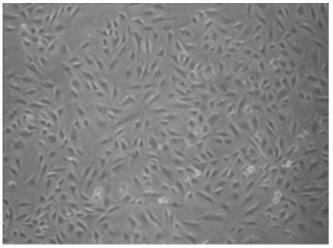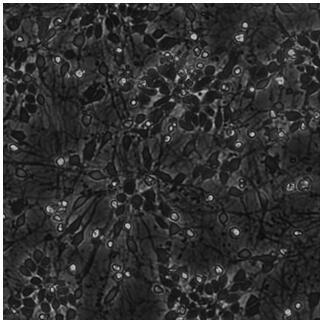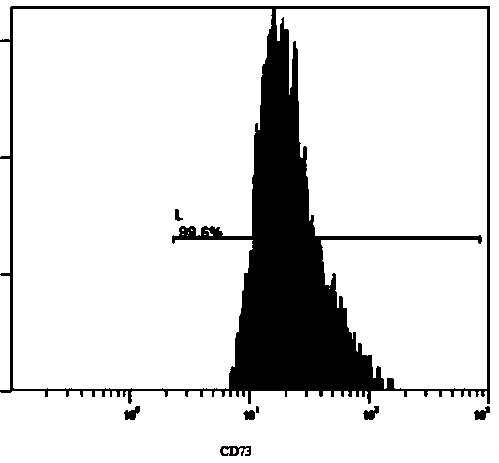Culture method for transforming human oral mucosal stem cells into astrocytes
An astrocyte and culture method technology, applied in the fields of biology and new medicine, can solve the problems of astrocytes with long time, inconsistent induction factors, and inability to use clinically, and achieves short induction time, repair of nerve defects, The effect of improving nerve function
- Summary
- Abstract
- Description
- Claims
- Application Information
AI Technical Summary
Problems solved by technology
Method used
Image
Examples
Embodiment 1
[0044] Example 1: A culture method for transforming human oral mucosal stem cells into astrocytes
[0045] Include the following steps:
[0046] (1) Culture of hOMSC
[0047] The human oral mucosa slices were washed twice with normal saline, cut into pieces with sterilized scissors, placed in low-sugar DMEM medium for culture, and added with a final concentration of 100U / mL penicillin and 100ug / mL streptomycin, 2mM gluten Aminoamide and 10% fetal bovine serum were used to obtain primary cells.
[0048] When the primary cells reached 70% confluence, they were digested with the digestive solution, centrifuged at 1500rpm for 5min, and 8000-10000 cells / cm 2 Density was inoculated and subcultured to obtain the third generation of human oral mucosal stem cells with consistent purity. Microscopic pictures are shown in the appendix figure 1 .
[0049] (2) Induction stage
[0050] The obtained third passage human oral mucosal stem cells were placed in NIM medium at 37°C, 5% CO 2 Th...
Embodiment 2
[0053] Example 2: Identification of hOMSCs
[0054] The cultured third-generation hOMSC cells were used for identification, and the surface markers of stem cells were identified by flow cytometry. Cell markers detected by flow cytometry include CD73, CD105, CD45, CD34 and nestin. The specific experimental steps are as follows:
[0055] (1) Collect the hOMSCs to be detected, wash the cells with PBS, and adjust the concentration of the cell suspension to 1-5×10 with PBS, 10% FCS, and 1% sodium azide 6 cells / mL, transferred to a Falcon tube.
[0056] (2) Dilute the conjugated primary antibody to 0.5ug / mL and add it to the Falcon tube. Incubate at 4°C for 30 min in the dark.
[0057] (3) Wash the cells three times, centrifuge at 400g for 5 min, and then resuspend in 1 mL of LPBS, 10% FCS, and 1% sodium azide.
[0058] (4) Test on the machine and analyze the experimental results.
[0059] The results are attached Figure 3-7 As shown, the expression rate of the third-generat...
Embodiment 3
[0060] Example 3: Identification method of astrocytes
[0061] (1) RT-PCR method:
[0062] First, use the RNeasy Plant Mini Kit (purchased from Qiagen, product number: 74904) to extract RNA from human oral mucosal stem cells (hOMSC) and human oral mucosal stem cell-induced astrocytes (hOMSC-Astroglia). For the extraction method, see the kit instructions . Use the PrimeScript RT reagent Kit with gDNA Eraser kit (purchased from TaKaRa, Cat. No.: RR047A) to reverse transcribe the two RNAs to form cDNA. For the operation method, see the kit instructions. The two cDNAs were used as templates, and fluorescent quantitative PCR reagents were purchased from Sano Company. The detected genes included NGF, GDNF, BDNF, GFAP, and EAAT2, and the β-atcin gene was used as an internal reference gene. Quantitative PCR primer sequences are listed in Table 1. Three replicates were set up for each PCR reaction. The program of RT-PCR was set as: 94°C for 3min, (94°C for 15s, 58°C for 30s, 72°C f...
PUM
 Login to View More
Login to View More Abstract
Description
Claims
Application Information
 Login to View More
Login to View More - R&D
- Intellectual Property
- Life Sciences
- Materials
- Tech Scout
- Unparalleled Data Quality
- Higher Quality Content
- 60% Fewer Hallucinations
Browse by: Latest US Patents, China's latest patents, Technical Efficacy Thesaurus, Application Domain, Technology Topic, Popular Technical Reports.
© 2025 PatSnap. All rights reserved.Legal|Privacy policy|Modern Slavery Act Transparency Statement|Sitemap|About US| Contact US: help@patsnap.com



